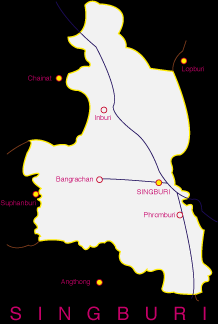 Changwat
Sing Buri was established in the year 1895 during the reign of King Rama
V through a consolidation of three small towns located on the bank of the
Chao Phraya River north of Ang Thong. The three small towns, Sing Buri,
In Buri, and Phrom Buri, were then established as a new town on the west
bank of the Chao Phraya River at Tambon Bang Putsa and name Muang Sing
Buri. Changwat Sing Buri currently occupies an area of 822 square kilometers
and is divided into six Amphoes : Muang, In Buri, Bang Rachan, Khai Bang
Rachan, Phrom Buri and Tha Chang.
Changwat
Sing Buri was established in the year 1895 during the reign of King Rama
V through a consolidation of three small towns located on the bank of the
Chao Phraya River north of Ang Thong. The three small towns, Sing Buri,
In Buri, and Phrom Buri, were then established as a new town on the west
bank of the Chao Phraya River at Tambon Bang Putsa and name Muang Sing
Buri. Changwat Sing Buri currently occupies an area of 822 square kilometers
and is divided into six Amphoes : Muang, In Buri, Bang Rachan, Khai Bang
Rachan, Phrom Buri and Tha Chang.
Tourist Attractions and Places of Interest:
Chaksi Reclining Buddha
This highly revered Buddha
image is housed at Wat Phra Non Chaksi, three kilometers from the township.
The Buddha image itself is almost 46 meters long and is open daily to the
public.
Monument Of Heroes And Khai
Bang Rachan Park
Khai Bang Rachan Park is an
arboretum for relaxation having a monument concerning the heroes of Bang
Rachan. The inauguration ceremony for this monument was performed by the
present King Rama IX. The figures on the monument refer to the villagers
of Bang Rachan who performed a unique performance in Thai history during
the reign of King Ekkathat in 1765 through fighting against the Burmese
enemy part of whose armed forces passed by Bang Rachan. Despite being many
more troops than the villagers, the Burmese troops had to make eight attacks
against the village before it was defeated due to its shortage of weapons.
Such heroic performance has been currently appraised among the Thai. The
fortress seen in the park area is the replica imitated from the ancient
actual design. There are some important statutory monuments such as Wat
Pho Kao Ton (Nine Bodhi Trees Monastery), a Vihara housing the statue of
Phra Archan Thammachot, a Buddhist monk who was an outstanding leader of
Bang Rachan villagers at that time. The Park is located 13 kms. away from
town on Sing Buri-Khai Bang Rachan-Suphanburi Road.
Wat Na Phrathat
This monastery first called
by the villagers "Wat Hua Muang" and later changed to the present name,
is located west of the Chaksi Reclining Buddha in Tambon Chaksi, Amphoe
Muang Sing Buri. It houses a very old prang which is assumed to have been
built during the ancient Khmer's glory.
Wat Phikun Thong
Called "Wat Luang Pho Phae"
by the villager, it is some nine kilometers from Wat Phra Non Chaksi (Chaksi
Reclining Buddha) in Tambon Wihan Khao, Amphoe Tha Chang. People from all
directions like to come to this monastery to pay their homage to Luang
Pho Phae. The main attractions of this monastery are (1) Thailand's largest
sitting Buddha image called 'Phra Yai Prathanphon' or 'Phra Phuttha Suwan
Mongkhon Mahamuni' constructed by Luang Pho Phae, and (2) Dharma Garden,
a peaceful corner for mind purification.
In Buri National Museum
There are several exquisite
archaeological subjects such as King Rama V's palanquin, large shadow play
characters of Wat Prasuk, various monk ranking ecelesiastical fans from
the period of King Rama V, Green stone Buddha Image, ancient sugar cane
crushing machine, etc. Near the museum lies Wat Bot, an old monastery having
a most unusual style of construction, e.g., using the iron rails as the
core of the lower part, and the entire Ubosot is of wooden work having
splendid craftmanship on its carved door and window panels.
Wat Sawang Arom
This monastery, situated in
Amphoe Muang, is a centre of Buddha image sculpting the technique of which
was handed down from Ban Chang Lor school in Thon Buri. The collection
of Nang Yai, a kind of shadow play at Wat Sawang Arom with 300 pieces in
good condition is the most complete in Thailand.
Wat Phra Prang and Noi River
Kiln Site
This is located in Tambon Choeng
Klat, Amphoe Bang Rachan, some 17 km. from Sing Buri township, the Wat
contains within its precincts a Prang assumed to be contructed during the
reign of King Narai the Great. The Prang measures 60 m. high with 20 m.
wide at its base. There is a hill topped with a reproduced Buddha's footprint
within the Prang. In addition, traces of 3-4 ancient kilns dating back
to Ayutthaya period had been found in a nearby area. The kilns were relatively
large and once produced various kinds of pottery such as jar, bowl, mortar,
pot, gable top, floor tile, etc.